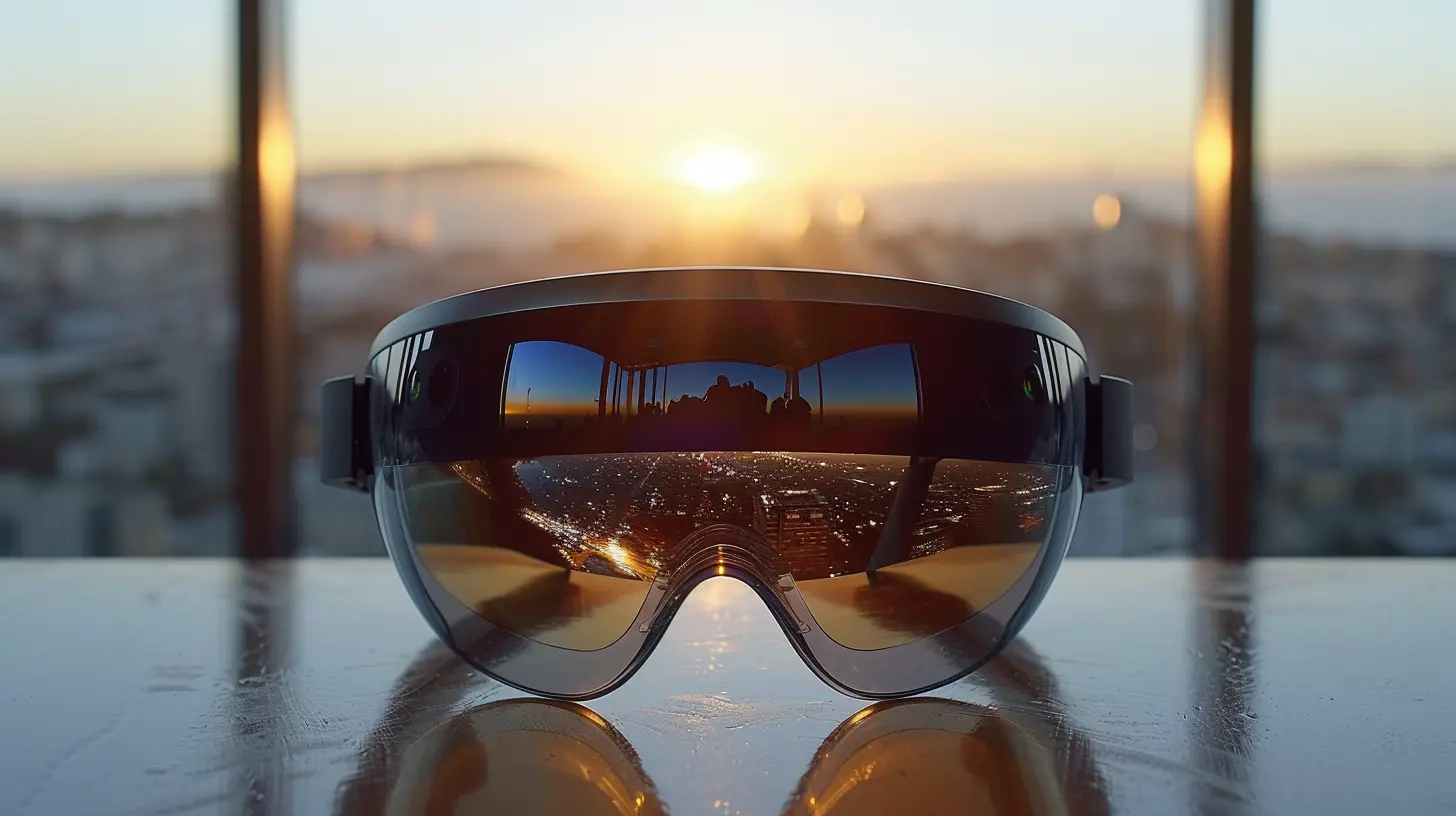The Role of Augmented Reality in Enhancing Remote Work
31 July 2025
Over the past few years, remote work has transformed from a workplace luxury to a global standard. Whether you're dialing in from your kitchen table or setting up a workstation in Bali (lucky you!), chances are you've experienced the ups and downs of working remotely. But here's the catch — remote work, although flexible, comes with big challenges: communication gaps, lack of collaboration, tech fatigue... the list goes on.
Now, what if I told you there's a game-changer out there that can turn remote work from “meh” to magical? Enter Augmented Reality (AR) — no, it’s not just for gaming or Snapchat filters anymore. It’s seriously stepping up to enhance how we work, connect, and create from anywhere on the planet.
Let’s dive into how AR is quietly — and quite literally — reshaping the remote work scene, one headset at a time.
What is Augmented Reality, Anyway?
Before we geek out too hard, let's make sure we’re all on the same page.Augmented Reality (AR) is tech that overlays digital content on top of the real world. Think Iron Man’s heads-up display or Pokémon GO making you chase creatures through city streets — except now, this same tech is showing up in our jobs.
Unlike Virtual Reality (VR), which drops you into an entirely simulated world (like being inside a sci-fi movie), AR keeps you grounded in the real environment and simply adds digital content on top. It's like wearing magic glasses that display helpful, interactive elements as you go about your day.
So, how does that tie into remote work?
The Growing Pains of Remote Work
Let’s face it, working remotely is a mixed bag. Sure, we get to rock sweatpants all day, but when it comes to collaboration, productivity, and maintaining human connection, things can get tricky.Here’s what's holding remote work back:
- Lack of Physical Presence: Video calls aren’t quite the same as face-to-face interaction. We miss out on body language, spatial context, and that natural human energy.
- Limited Collaboration Tools: Screen sharing and chat apps can only go so far. Complex tasks like design, product assembly, or technical training just don’t translate well over Zoom.
- Burnout from Digital Fatigue: Staring at a screen for 8+ hours? Not fun. And let's not forget the dreaded “Zoom fatigue.”
These challenges can make remote work feel, well... isolating and inefficient.
How AR Is Changing the Remote Work Game
Now here’s the fun part. AR swoops in like a superhero to solve a lot of these issues. But how, exactly?Let’s break it down.
1. Real-Time Remote Collaboration
With AR, remote collaboration doesn’t stop at video calls. Imagine putting on a pair of smart glasses and seeing your colleague's annotations appear directly on your work surface.Sounds like sci-fi? It's real, and companies are already using it.
AR-powered collaboration tools allow:
- 3D Object Manipulation: Designers can tweak a product prototype together in real time, as if they’re in the same room.
- Interactive Whiteboards: Participants can brainstorm in a shared virtual space layered over their physical one.
- Live Remote Assistance: Support teams can provide step-by-step guidance by drawing on your field of view instead of trying to explain through laggy video.
This kind of immersive interaction is a game-changer, especially for industries like architecture, engineering, and manufacturing.
2. Training and Onboarding Go Next-Level
Ever started a new job remotely and felt completely lost? Yeah, been there.AR can make onboarding way more intuitive and less awkward. Instead of reading a boring PDF or watching a 45-minute training video, imagine using your phone or headset to get hands-on, interactive tutorials that guide you through tasks in real time.
For example:
- AR Manuals: Point your phone at a machine and get instant step-by-step instructions.
- Simulated Scenarios: Practice health & safety protocols in an AR environment without putting anyone at risk.
- Gamified Learning: Turn employee training into an engaging AR experience with rewards and progress tracking.
Companies save time, employees learn faster, and everyone wins.
3. Enhanced Remote Meetings
Let’s be real, most virtual meetings are a snoozefest. You’re either zoned out, muted with your camera off, or multitasking through another spreadsheet.AR flips the script.
Picture this: Instead of everyone being crammed into rows of video tiles, you meet in a shared 3D environment. You can stand beside a coworker (virtually), walk around a concept model, or present your pitch in an immersive AR boardroom.
You don’t just talk about the project — you walk around inside it.
This spatial experience adds depth, context, and (honestly) a lot more excitement to remote meetings.
4. Boosting Productivity With Smart Tools
AR doesn’t just make things look cool — it actually helps you get stuff done faster and smarter.Tools like AR dashboards, overlays, and reminders can help you:
- Visualize Data in 3D: Instead of staring at flat charts, analyze sales data in a room-sized holographic graph (Tony Stark style).
- Stay Focused: AR environments can be customized to minimize distractions — think of it as your digital Zen workspace.
- Multitask Efficiently: With hands-free controls and voice commands, AR lets you juggle tasks without switching tabs 50 times.
For workers in technical fields, remote diagnostics and visual data overlays can cut down error rates and turnaround times significantly.
5. Bridging the Human Connection Gap
Let’s not forget the human side of remote work. Feeling connected to your team (even from miles away) is vital for morale and mental health.AR helps by simulating presence. Avatars, shared spaces, and virtual coffee rooms add fun and spontaneity back into your workday.
Sure, no tech can replace a real high-five after a big win — but AR might be the next best thing.
Real-World Use Cases: Who’s Doing This Right?
Some companies are already ahead of the curve when it comes to AR in remote work.- Boeing and Lockheed Martin use AR to guide technicians through complex wiring or assembly processes — all remotely.
- Microsoft HoloLens is helping doctors consult on surgeries and collaborate with peers across the globe in real time.
- Porsche is equipping auto service teams with AR glasses to receive expert guidance from HQ while working hands-on with vehicles.
These aren’t just cool gimmicks — they're real-world solutions saving time, money, and reducing human error.
Challenges to Keep in Mind
Okay, before we get too starry-eyed — let’s talk hurdles. AR in remote work is exciting, but it’s not all rainbows and butterflies just yet.Some roadblocks include:
- High Initial Costs: AR gear and software isn't cheap (yet).
- Learning Curve: Not everyone’s ready to strap on a headset and dive in.
- Tech Compatibility: Integrating AR tools with current systems can be sticky.
- Privacy Concerns: Recording and sharing real-time views opens up new data privacy questions.
But as with most technologies, these issues tend to smooth out as they become more mainstream and affordable.
The Future of Remote Work Is More “Real” With AR
Here's the bottom line: Remote work is here to stay — and AR is going to help us do it better.It bridges the sensory gap between physical and digital workspaces, making everything feel more intuitive, efficient, and — dare I say — human again.
As more companies adopt AR tools, we'll probably look back at 2D video calls and endless email threads and wonder how we ever got anything done.
Are we fully there yet? Not quite. But AR is picking up steam, and it’s only a matter of time before putting on an AR headset becomes as normal as logging into Slack.
So maybe, just maybe, your next big presentation won’t be on a PowerPoint slide... it’ll be floating in front of your audience, ready to be explored.
Now that’s the kind of future we can get excited about.
Wrapping It Up
Let’s not underestimate the role of AR in enhancing remote work. While it may have started out as a novelty for gamers and techies, AR is becoming an essential tool for collaboration, communication, and creativity in the digital workspace.From making remote meetings feel more immersive, to streamlining training, to simply helping teams feel more connected — AR is turning remote work from a workaround into a full-blown workflow revolution.
If you’re working remotely and feeling disconnected, burned out, or stuck in the same old routines — maybe what you need isn’t just a new schedule or Zoom background. It might just be a new (augmented) reality.
all images in this post were generated using AI tools
Category:
Augmented RealityAuthor:

Gabriel Sullivan
Discussion
rate this article
1 comments
Alice Cook
Exciting to see AR transforming remote work! Can't wait to try it!
August 9, 2025 at 1:01 PM

Gabriel Sullivan
Thank you! We're thrilled about the potential of AR in remote work as well. Exciting times ahead!


